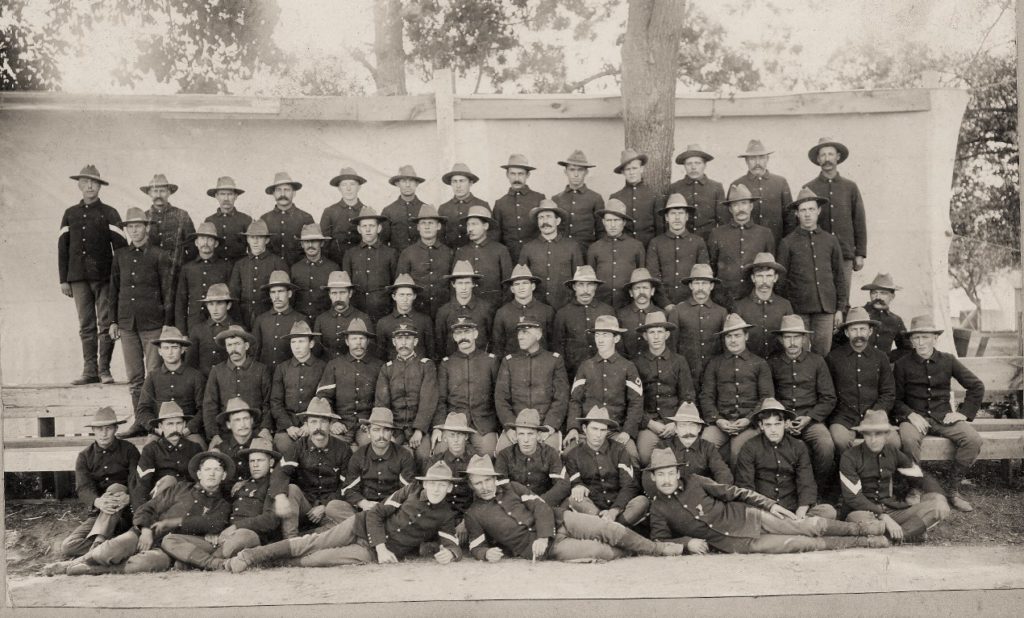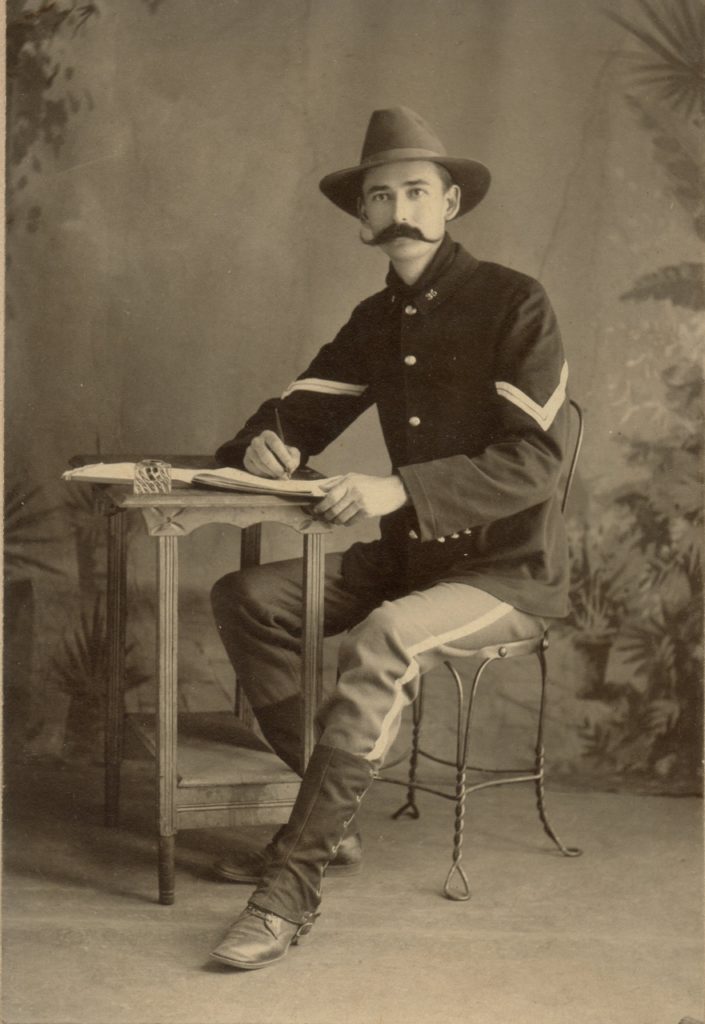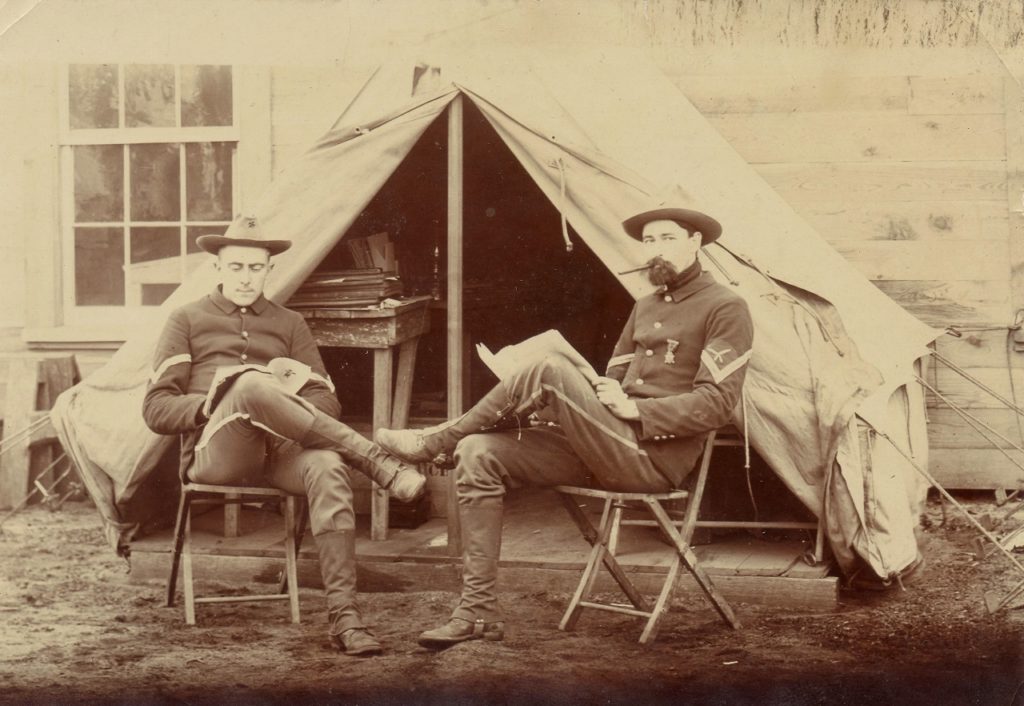
September 27, 1898 image of Spanish American War volunteers from Schoolcraft County. The photo was taken at Camp Eaton, Island Lake, Michigan, by Schoolcraft County Clerk Ed Ashford. Niles and Helmka Family Collection
War with Spain
On February 15, 1898 the American battleship Maine exploded in Havana harbor. The event would soon become the catalyst for hostilities between the United States and Spain. With growing calls for war from politicians led by Teddy Roosevelt, President William McKinley made his first call for 125,000 troops on April 23, 1898. Michigan responded to the President’s call for troops, by attempting to nationalize the existing Michigan National Guard. The troops were not allowed to be mustered in as units, but instead were required to volunteer individually. Nearly every member of Michigan’s National Guard volunteered for the war.
A Second Call for Troops
On May 25, 1898, President McKinley issued a second call for 75,000 troops which included not only National Guard troops, but also included the general citizenry. The volunteers from Schoolcraft County became members of Company B and Company I of the 35th Michigan Infantry. By the time the regiment was fully mustered into service at the end July of 1898, the war’s major fighting had already been concluded.
Volunteers from Schoolcraft County who were assigned to the 35th Michigan Infantry, Co. B included: Frank E. Helmka, Corporal; Arthur J. Hughson, Corporal; Edward J. Curley Jr., Corporal and Fred Brassel, Corporal. Privates included: Fred W. Bills, Seymour D. Crittenden, Charles E. H. Smith, Bert J. Wadleigh and James A. Wilber. The recruits from Company B were all members of the Son’s of Union Veterans of the Civil War camp in Manistique.
Volunteers who were assigned to Company I, 35th Michigan Infantry included: Charles W. Adkins, 2nd Lieut.; William A. Burdick, Sergt.; William. S. Putnam, Sergt.; John McWilliams, Sergt.; John G. Case, Sergt.; Thomas H. R. Silverhiehn, Sergt.; Harry C. D. Ashford, Corporal; Charles Smithers, Corporal; Andrew W. Paulsen, Corporal; George L. Rose, Corporal; John P. Anderson, Corporal; Fred Byers, Musician; George Anderson, Artificer and Patrick Gratton, Wagoner; all from Manistique. Privates included: William Boatman, Abram D. Boomer, James F. Bloomer, James G. Crilley, Will Caplin, Rock Chartier, Peter R. Clare, Oscar Dentin, Louis Dahlberg. Alexander Daignadt, Henry Evert, Archie Gonyea, William R. Galbraith, William Gordon, Henry B. Hursh (Thompson),Henry T. John, Nicholas Kendall, Millard L. Kump (Gulliver), Napoleon Labronche, Oliver Lafreniere, Otto Lagman, Murdick McNeil, Charles McKay, Charles Nass, Mikeal F. O’Donnell, Godfrey A. J. Olson, Edward J. Palmer, Frank Riley, Alfred Sisco, Michael Smith (Thompson), William E. Smith, Jr., Johial Sheets and Leroy M. Woodruff, all from Manistique except where otherwise noted.

Quartermaster Sergeant Frank E. Helmka (1898) Niles and Helmka Family Collection
The men of the 35th Michigan Infantry did not see any action during the Spanish American War as they spent their entire enlistment in the United States. The regiment was mustered into service at Camp Eaton, Island Lake, Michigan during the month of July. After receiving initial training at Camp Eaton, they were transferred to Camp Mead in Pennsylvania, where they remained until November 10, 1898. From there, the unit was ordered south to Camp Mackenzie in Augusta, Georgia. The end of the war followed shortly thereafter, with the signing of the Treaty of Paris on December 10, 1898. The regiment was mustered out of service on March 31, 1899 at Augusta, Georgia. Disease, and not the Spanish was the real enemy of the 35th. The regiment sustained losses of one officer and 24 enlisted men who died from disease and 38 men were discharged due to disability.

Above is a January 23, 1899 image of two officers, sitting in front of their tent at Camp Mackenzie in Augusta, Georgia. The soldier on the right is Frank Helmka. (Niles and Helmka Family Collection)
